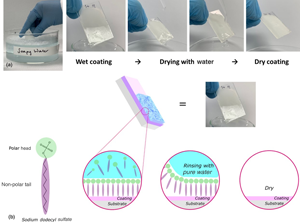Crossref Citations
This article has been cited by the following publications. This list is generated based on data provided by
Crossref.
Wang, Jie
Zhang, Ling
and
Li, Chunzhong
2022.
Superhydrophobic and mechanically robust polysiloxane composite coatings containing modified silica nanoparticles and PS-grafted halloysite nanotubes.
Chinese Journal of Chemical Engineering,
Vol. 52,
Issue. ,
p.
56.
Cao, Dong
Ji, Shijun
Zhao, Ji
Liu, Zhenze
and
Dai, Handa
2022.
Design and superhydrophobic performance analysis of the rectangular-groove microstructure coated by nanocoatings.
Materials Chemistry and Physics,
Vol. 291,
Issue. ,
p.
126539.
Lei, Xue
Xie, Ailing
Yuan, Xinya
Hou, Xueni
Lu, Jiaosheng
Liu, Ping
Xiang, Zhonglin
Chen, Guoqiang
and
Xing, Tieling
2022.
Fabrication of Superhydrophobic and Light-Absorbing Polyester Fabric Based on Caffeic Acid.
Polymers,
Vol. 14,
Issue. 24,
p.
5536.
Li, Shuai
Li, Yanwei
Tan, Yiqiu
Li, Jilu
Wang, Di
Yuan, Dongdong
and
Zhang, Jianli
2023.
A Sustainable Superhydrophobic and Photothermal Coatings for Anti-Icing Application on Concrete with a Simple Method for CNTs/SiO2 Modification.
Sustainability,
Vol. 15,
Issue. 22,
p.
15865.
Liu, Xiaohu
Liu, Huamin
Li, Yi
Teng, Fei
and
Liang, Ce
2023.
Superhydrophobic surface of hybrid nanocomposites made of TiO2 and multi-walled carbon nanotubes: Photothermal ice removal performance and wear resistance.
Applied Surface Science,
Vol. 640,
Issue. ,
p.
158318.
Yang, Yu
Zhang, Hai
Cao, Lei
Meng, Weikai
Ma, Xinru
Li, Xinzi
Zheng, Junping
and
Liu, Xiaofei
2024.
No‐organic solvent, no‐fluorinated waterborne superhydrophobic coatings based on SiO2 and IBTS.
Journal of Applied Polymer Science,
Vol. 141,
Issue. 25,
Peng, Mengyuan
Wang, Qi
Sha, Min
Jiang, Biao
and
Zhang, Ding
2025.
Durable self-cleaning superhydrophobic composite coatings based on fluorine-modified organic polysilazane and SiO2 particles prepared by facile spraying technique.
Chinese Journal of Chemical Engineering,
Vol. 85,
Issue. ,
p.
335.
Ji, Wanli
and
Zhong, Shaofeng
2025.
Fabrication of robust and sustainable superhydrophobic cotton fabrics via surface micro-dissolve method for oil/water separation.
Cellulose,
Vol. 32,
Issue. 2,
p.
1119.


